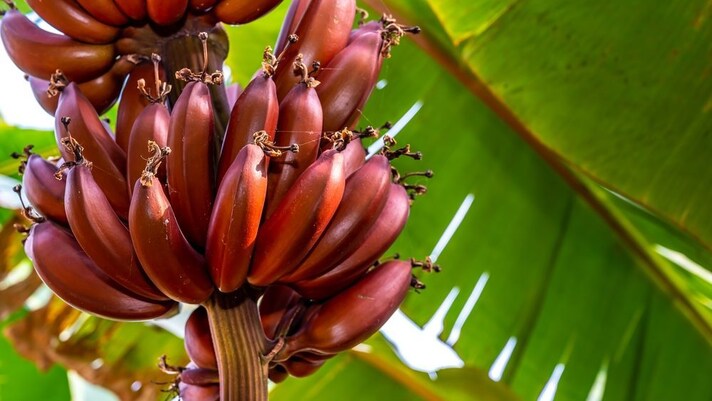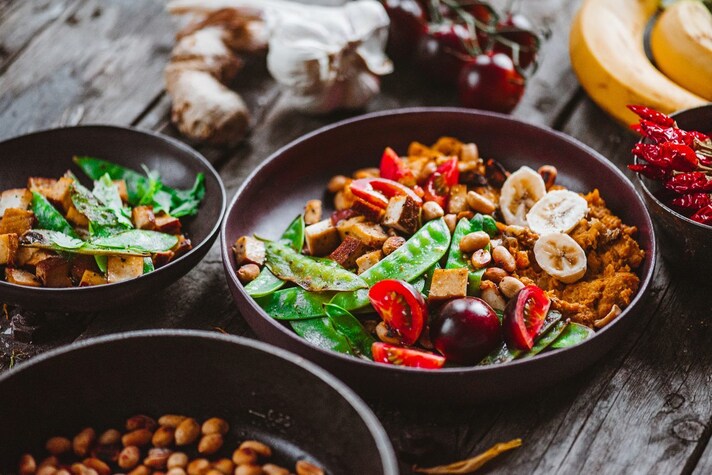What Are Red Bananas, What Do They Taste Like And How Can You Eat Them?
From the distant lands of Southeast Asia, an exotic fruit has conquered palates around the world: the red banana. With its intensely colored skin and sweet, creamy pulp, this variety of banana stands out for its unique characteristics: here's what red bananas are made of, their benefits, and how to use them in the kitchen.
;Resize,width=742;)
Also known as Cuban banana, the red banana is a fruit with ancient origins: a lesser-known variety than the yellow ones, but equally rich in beneficial properties and a unique flavor. It is a "mini" variant of the more classic and well-known yellow banana, which has curious tips of color that, depending on the different degree of ripeness, oscillate between purple and brown, passing through red; inside a tender cream-colored pulp and a sweet and pleasant flavor, with a lovely aftertaste of raspberries.
What Are Red Bananas and Why Are They…Red?
Originating in Southeast Asia, red bananas have spread to several tropical regions, including Central America, Africa and Australia: today they are mainly produced in Thailand, Ivory Coast, Colombia and Ecuador. The plant is the same as yellow bananas, Musaceae, but red bananas come from different varieties. The most common yellow ones belong mainly to the Cavendish variety, while red bananas belong to different varieties, such as the "Red Dacca" or the "Cuban Red".
The red color of red bananas is mainly due to the presence of pigments called anthocyanins in the peel: these pigments are responsible for the red, purple and blue colors in many plants, including fruits and flowers. The concentration and type of anthocyanins present in the peel determine the specific shade of red: these varieties have naturally developed the ability to produce anthocyanins in the peel.
The color of the peel of red bananas changes as they ripen: initially, the peel can be a red-purple color, and becomes darker, tending towards brown, when the banana is fully ripe. Finally, exposure to the sun can also influence the intensity of the color of the peel.

Differences With Yellow Bananas
Red and yellow bananas, although belonging to the same family, have several significant differences: in addition to the color of the skin, the most obvious difference, red bananas tend to be smaller and stockier than yellow bananas. In addition, red bananas have a sweeter and more delicate flavor, with a slight aftertaste reminiscent of raspberry, while yellow bananas have a more common and less intense flavor. The flesh of red bananas is generally creamier and softer than that of yellow bananas.
Their properties also differ: unlike yellow bananas, red bananas contain anthocyanins, antioxidant pigments that give them their red color and offer health benefits. They also contain a higher content of beta-carotene, a precursor to vitamin A, important for eyesight and skin, but also vitamin C than yellow bananas. Red bananas have a slightly lower glycemic index than yellow bananas, which means they release sugar into the blood more slowly.

Benefits and Properties of Red Bananas
Red bananas offer a variety of health benefits, thanks to their rich nutrient content. Here are some of their most important properties:
1. Antioxidants
As mentioned, red bananas contain anthocyanins, powerful antioxidants that help protect cells from free radical damage, and beta-carotene, which is important for healthy eyesight, skin, and the immune system. They also contain significant levels of vitamin C, another powerful antioxidant that strengthens the immune system and promotes collagen production.
2. Benefits for The Heart
Red bananas are rich in potassium, a mineral essential for cardiovascular health, which helps regulate blood pressure and prevent hypertension. They also contain a good level of fiber, which helps reduce bad cholesterol (LDL) and improve heart health.
3. Friends of Digestion
Their fiber content also helps promote intestinal regularity and prevent constipation; but also prebiotics, which they are rich in, help nourish the beneficial bacteria in the intestine, promoting a healthy intestinal flora.
4. Energy Mine
The combination of carbohydrates and mineral salts such as potassium and magnesium is very useful for those who need immediate energy: red bananas are in fact an excellent pre-workout snack. Mineral salts also help prevent muscle cramps during physical activity.
5. A Mood Booster
Red bananas can help improve your mood, thanks to their tryptophan content, a precursor to serotonin. They also have a slightly lower glycemic index than yellow bananas, which means they release sugar into the blood more slowly.
How to Use Them in The Kitchen
Red bananas, with their sweet flavor and creamy texture, are a versatile ingredient in the kitchen. The easiest way to enjoy red bananas is to eat them fresh, once ripe: add them to fruit salads for an exotic touch. You can blend them with milk, yogurt or fruit juice for a delicious and nutritious drink, or add them to milkshakes and smoothies for a sweet and creamy flavor. Red bananas can be used, just like yellow ones, to prepare cakes, muffins and banana bread. They are perfect for homemade ice cream and sorbets, but also for quick desserts: caramelize them in a pan with sugar and cinnamon and you will have an inviting dessert in just a few minutes. They are also excellent for making jams and preserves.
In some cuisines, such as Thai and Indian, red bananas are used in savory dishes. In some regions of India, for example, they are used in dishes such as curries or stews, to add a sweet and sour touch; they are also fried, after having dipped them in batter, creating a fried dessert called Pazhampori. They are also often served fried as a side dish.

In Thai cuisine, red bananas can be used in meat or fish curries, offering a very interesting contrast of flavors, while in the Caribbean they are used to make traditional desserts, smoothies and fruit salads.
;Resize,width=767;)
;Resize,width=712;)

;Resize,width=712;)
